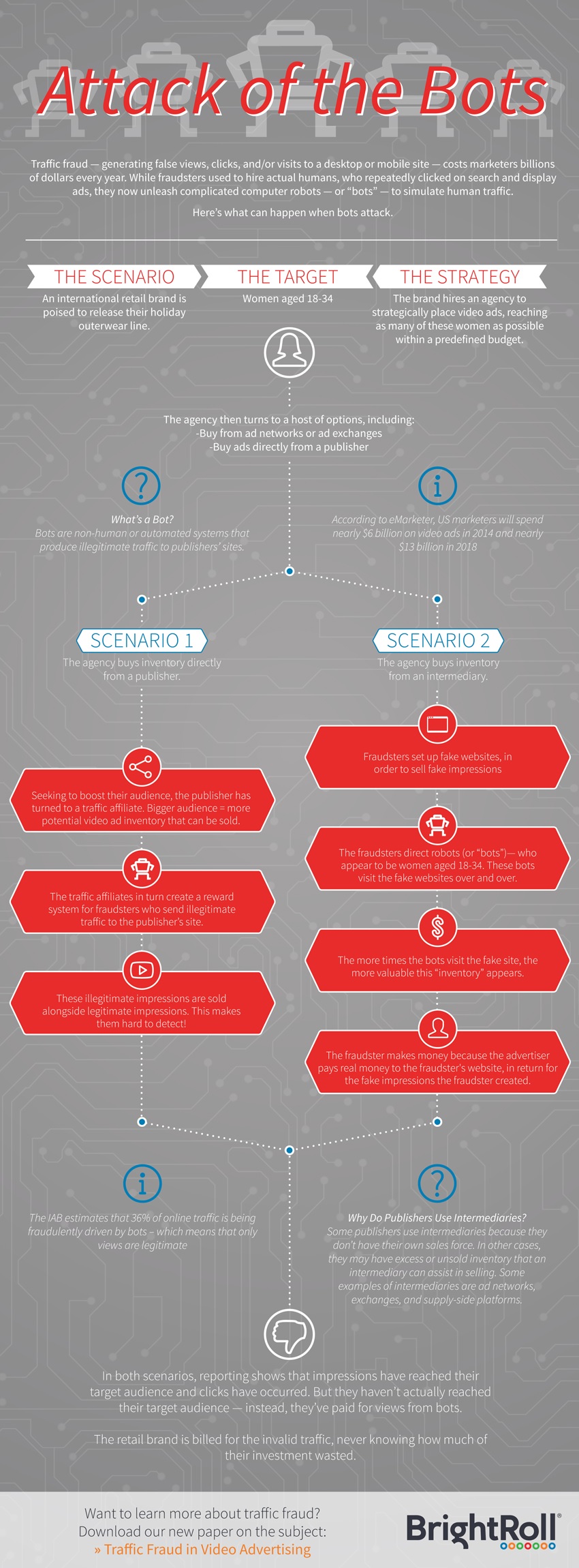Online advertising is now a $122 billion global industry and, in the coming years, is predicted to surge past TV to become the number one advertising channel. While the industry is flourishing, traffic fraud continues to be one of the biggest challenges for marketers. Tod Sacerdoti, CEO and founder, BrightRoll, offers 6 tips to fight video ad traffic fraud.
In its current incarnation, traffic fraud is primarily the use of computer-generated “bots” visiting a website which is designed to fool advertisers that they are actual consumers; on a lesser scale, it is the use of humans to a click on an ad with no intention to buy.
The Interactive Advertising Bureau estimates that up to 36 per cent of web traffic is generated through “bots”. While the problem of traffic fraud is not scaring off marketers from advertising online, it is an unfortunate reality that is costing advertisers billions of dollars in wasted ad spend every year.
Understandably, advertisers are concerned as they expect real consumers with buying potential to view their ads. Fraud has plagued the online advertising industry for years, as the open nature of digital media, coupled with its spiralling growth, has made it happy hunting ground for fraudulent behaviour.

Before we move on, let’s give a bit of background. Twenty years ago, the industry was in its infancy and fraudsters used the labour intensive practice of hiring humans to repeatedly click on search and display ads. But this proved costly, so criminals refined the model to build computer-based methods to simulate humans clicking on ads. They also used sophisticated technologies to redirect legitimate traffic to fake publisher’s sites. For the most part, publishers unwittingly sold these “fake clicks” to advertisers.
The industry’s biggest search engines have all faced click fraud within their marketplaces. As the industry evolved from search to display, these fraudsters matured and are now taking dead aim at the increasingly lucrative video ad space.
The sector is growing so rapidly that by 2018, eMarketer estimates that US marketers are expected to spend nearly $13 billion on video ads. Additionally, the cost of a video ad is a lot higher than the price of a display ad, meaning that fraudulent dealers can make more from every fake video ad impression.
With so much at stake, advertisers are seeking out ways to ensure that real people are viewing their ads.
There are steps that marketers can take to minimise their risk of encountering fraudulent activity. Although none are 100 per cent fool proof, using them will ensure that marketers are taking the necessary steps to squeeze out criminal behaviour.
1. Use accredited, third-party verification services to complement the tools most media sellers develop in-house. This is a necessary addition to any fraud protection services your media seller provides. Look for an independent third-party measurement company that is not involved in buying or selling media; your referee shouldn’t also be playing the game. If a media seller’s numbers can’t be verified, or are dramatically different than those reported by a third party, consider that a red flag.
2. Establish your target audience, and verify that it’s been reached. Define your goals in terms of audiences rather than only numbers of impressions. Work with your media seller to make sure these audiences are being specifically targeted. Verify that your ad has been shown to your target demographics. Use an impartial, independent third party such as comScore or Nielsen to verify that your target audience was actually reached.
3. Use platforms that are certified compliant with IAB Quality Assurance Guidelines. Your buying software should comply with industry best practices around transparency, and using IAB certified partners is a key step in the collective effort required to mitigate the problem. Sophisticated DSPs enable you to filter the inventory you buy based on the IAB’s QA guidelines.
4. Review the site URLs your ads run on. Your brand is accountable for its ad placement, so you need to know where your impressions are running. Get specifics on URLs before your ads run and ensure your third-party verifier is continually reviewing and verifying those URLs.
5. Determine upfront what recourse your supplier provides for fraudulently-served impressions. Should you confirm that your traffic has been affected by fraud, you and your supplier will need an agreed-upon plan of recourse. Will the supplier refund money you’ve paid for fraudulent impressions, or “make good” with legitimate impressions?
6. Participate in industry efforts to mitigate the problem. The key to success in solving this problem will be collective action by advertisers, publishers and tech platforms. Industry efforts such as the IAB, 4A’s and ANA’s trustworthy accountability group are lining up to make it easier for all of us to work collectively to solve this problem.
Traffic fraud is not a new problem, but with the rapid rise of digital video, the stakes are higher today than ever before. The key to solving this problem will be a collective effort by advertisers, publishers and tech platforms, many of which are already taking unprecedented steps to combat traffic fraud. For advertisers to succeed, they must protect themselves through education on best practices and new technologies. Only then can they ensure that their ad dollars spent on online video lead to legitimate, impactful impressions.
To learn more about traffic fraud and how brands and agencies can protect themselves, download BrightRoll’s latest whitepaper “Traffic Fraud In Video Advertising.”
http://www.brightroll.com/
